L'Oréal Bundle
Can L'Oréal Maintain Its Beauty Empire?
The beauty industry is a whirlwind of innovation, consumer trends, and fierce competition. L'Oréal, a titan in this arena since 1909, has consistently adapted and thrived. With a recent financial performance that speaks volumes, the company's ability to navigate this dynamic landscape is a key area of interest.
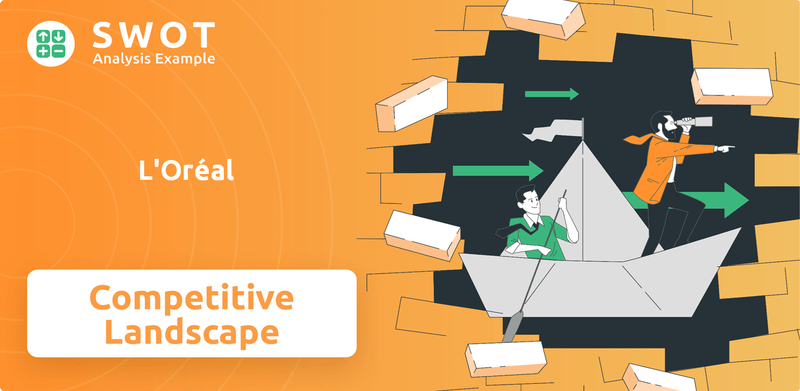
This exploration into the L'Oréal competitive landscape will provide a thorough L'Oréal market analysis. We'll dissect L'Oréal's strategies and examine its rivals in the cosmetics market share. Understanding the L'Oréal industry dynamics is crucial to assess its future, and a detailed L'Oréal SWOT Analysis can provide deeper insights into its strengths and weaknesses compared to its L'Oréal competitors and its overall market position in skincare and other segments.
Where Does L'Oréal’ Stand in the Current Market?
L'Oréal maintains a strong market position as the world's largest beauty company, offering a diverse range of products to meet various consumer needs. In 2024, the company achieved sales of €43.48 billion, outperforming the global beauty market. Its market capitalization reached €182.6 billion by the end of December 31, 2024. This demonstrates L'Oréal's significant presence and financial strength in the beauty industry.
The company's main product categories include skincare and sun protection, makeup, haircare, fragrances, and hair coloring. L'Oréal operates in over 150 countries, with a significant geographic presence. The company's strategic focus on both mass market and luxury brands, combined with its strong e-commerce performance, positions it well within the competitive landscape. This approach has contributed to its robust financial health and sustained growth.
L'Oréal's global market share in the beauty industry is substantial, driven by its diverse brand portfolio and widespread distribution network. In 2024, sales reached €43.48 billion, reflecting its strong market position. The company's performance consistently outpaces the overall beauty market, demonstrating its competitive advantages.
Europe was a key driver of growth for L'Oréal in 2024, with sales increasing by 9.3%. Emerging markets, particularly SAPMENA-SSA, also showed strong growth, with a 10.4% increase in Q1 2025. While North America experienced a decline in Q1 2025, the company's global presence helped to offset these regional variations.
L'Oréal's product portfolio includes skincare and sun protection (39% of sales), makeup (19%), haircare (16%), fragrances (14%), and hair coloring (8%). This diversified product range allows L'Oréal to cater to a broad consumer base and mitigate risks associated with market fluctuations in specific categories.
E-commerce sales for L'Oréal reached €12.3 billion in 2024, representing 28.2% of total sales. This growth, at 7.8%, highlights the company's successful digital transformation. L'Oréal's digital strategy is a key factor in its ability to compete effectively and reach consumers globally.
L'Oréal's financial health is robust, with a record operating margin of 20% of sales in 2024 and an increase of 6.7% in operating profit to €8.69 billion. Net income for 2024 was €6.40 billion. These strong financial results underscore L'Oréal's competitive advantages within the beauty industry.
- Global Presence: Operating in over 150 countries provides a broad market reach.
- Brand Portfolio: A diverse range of brands caters to various consumer segments.
- E-commerce Strength: Significant online sales and digital transformation efforts.
- Financial Stability: Record operating margins and strong profitability.
Analyzing the Growth Strategy of L'Oréal reveals how the company has maintained its market position. L'Oréal's ability to adapt to changing consumer preferences and market dynamics is a key factor in its continued success. The company's focus on innovation, sustainability, and digital marketing further strengthens its competitive position in the beauty industry.
L'Oréal SWOT Analysis
- Complete SWOT Breakdown
- Fully Customizable
- Editable in Excel & Word
- Professional Formatting
- Investor-Ready Format
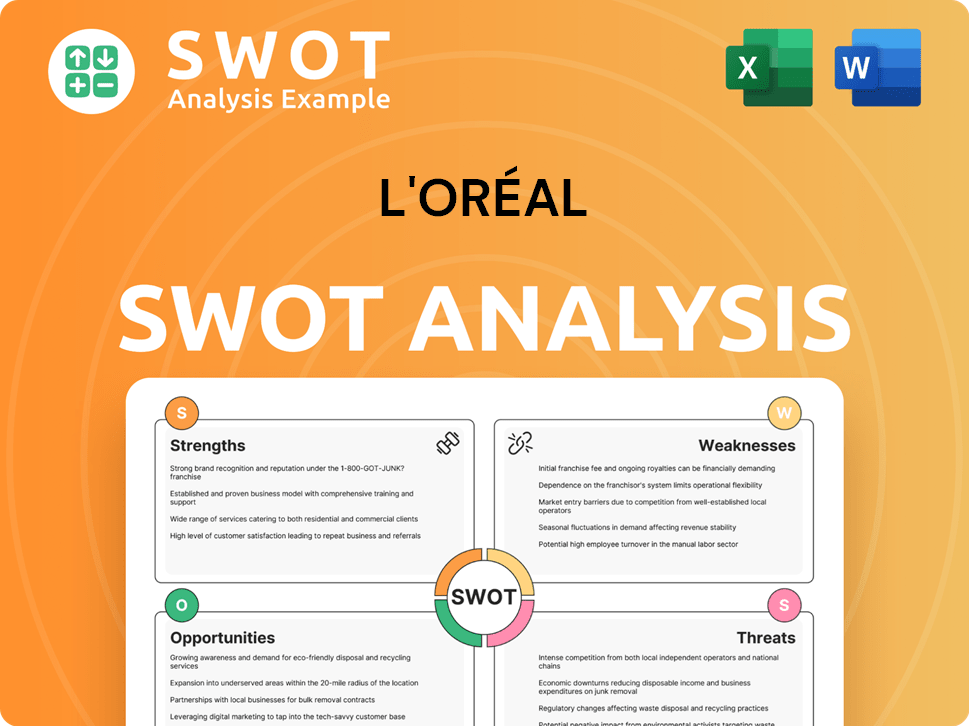
Who Are the Main Competitors Challenging L'Oréal?
The L'Oréal competitive landscape is characterized by intense rivalry within the beauty and personal care sector. The company faces competition from established multinational corporations and emerging niche players. Understanding the dynamics of these competitors is crucial for analyzing L'Oréal's market analysis and strategic positioning.
L'Oréal's ability to maintain and grow its market share depends on its strategies to beat competition and adapt to evolving consumer preferences and market trends. This includes innovation, brand portfolio management, and effective marketing.
L'Oréal's main rivals include major players like Estée Lauder, Procter & Gamble (P&G), and Unilever. These companies compete across various segments of the beauty industry, from luxury skincare to mass-market haircare. The competitive environment is also shaped by new entrants focusing on clean beauty, sustainability, and digital-first strategies.
Estée Lauder is a significant competitor in the prestige beauty segment, directly challenging L'Oréal's Luxe division. The company's portfolio includes high-end skincare, makeup, fragrance, and haircare brands. In Q4, L'Oréal reported a 3.2% decline in sales in Asia, while Estée Lauder experienced an 11% decline in the same period, indicating L'Oréal's resilience.
P&G competes across various segments, particularly in the mass-market haircare and skincare categories. They often challenge L'Oréal through competitive pricing and extensive distribution networks. For example, in mainland China, L'Oréal's mass-market divisions face competition from generics like CeraVe.
Unilever also competes with L'Oréal across various segments, especially in mass-market products. They have a broad brand portfolio that allows them to compete effectively. Both P&G and Unilever are major players in the beauty industry competition.
New and emerging players, particularly those focused on clean beauty, sustainable products, and digital-first strategies, are shaping the L'Oréal competitive landscape. These companies often leverage digital marketing and direct-to-consumer strategies to gain market share.
Mergers and alliances also impact competitive dynamics. For example, L'Oréal's acquisitions of the Miu Miu license and Korean brand Dr.G, and minority stakes in Galderma and Amouage in 2024, further strengthen its portfolio and market reach, enhancing its L'Oréal's market position in skincare.
L'Oréal's competitive landscape varies by region. In China, for example, the company faces intense competition from both international and local brands. Understanding these regional dynamics is crucial for L'Oréal's global market share and strategic planning. The L'Oréal's competitive landscape in China is particularly dynamic.
L'Oréal's strategies to beat competition involve a combination of innovation, brand portfolio management, and digital marketing. Recent acquisitions and investments in R&D are key to maintaining a competitive edge. For more insights into L'Oréal's marketing strategies, you can read the Marketing Strategy of L'Oréal.
- Innovation and R&D: L'Oréal's investment in research and development is crucial for staying ahead of competitors.
- Brand Portfolio Management: Managing a diverse portfolio of brands across different segments allows L'Oréal to cater to a wide range of consumers.
- Digital Marketing: L'Oréal's digital marketing strategy is essential for reaching consumers and competing with digital-first brands.
- Sustainability: Sustainability initiatives are increasingly important for attracting consumers and gaining a competitive edge.
- Strategic Acquisitions: Acquisitions, such as the Miu Miu license and stakes in Galderma and Amouage, strengthen L'Oréal's market position.
L'Oréal PESTLE Analysis
- Covers All 6 PESTLE Categories
- No Research Needed – Save Hours of Work
- Built by Experts, Trusted by Consultants
- Instant Download, Ready to Use
- 100% Editable, Fully Customizable
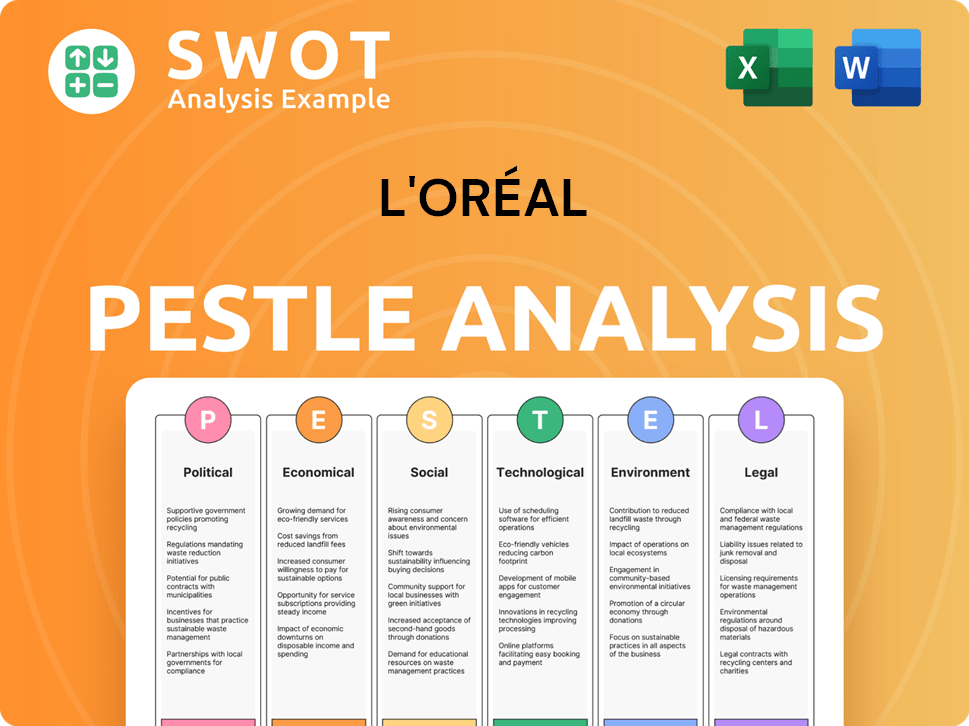
What Gives L'Oréal a Competitive Edge Over Its Rivals?
The Growth Strategy of L'Oréal highlights its robust competitive advantages in the beauty industry. L'Oréal's sustained leadership is built on a diverse brand portfolio, significant investment in innovation, a strong global presence, and enduring brand equity. These strengths enable the company to navigate the complex cosmetics market and maintain a leading position against its competitors.
L'Oréal's competitive landscape is shaped by its ability to innovate and adapt to changing consumer preferences. The company's commitment to research and development, coupled with its global reach and robust distribution network, allows it to consistently launch new products and capture market share. This strategic approach has positioned L'Oréal as a formidable player in the beauty industry, capable of withstanding competitive pressures and driving growth.
The company's strategic moves and competitive edge are further enhanced by its focus on sustainability and digital transformation. These initiatives not only resonate with environmentally conscious consumers but also streamline operations and enhance customer engagement. These factors collectively contribute to L'Oréal's strong market position and its ability to compete effectively in the global beauty market.
L'Oréal's diverse brand portfolio, including names like L'Oréal Paris, Maybelline, and Lancôme, caters to a wide range of consumer preferences. This broad appeal allows the company to capture market share across mass market, luxury, and active cosmetics segments. The variety in its offerings helps L'Oréal to maintain a strong position in the beauty industry competition.
L'Oréal invests over €1 billion annually in research and development, employing over 4,000 scientists. In 2024, the company filed 694 patents, demonstrating a strong commitment to innovation. This dedication to scientific advancement leads to cutting-edge products and technologies, reinforcing its competitive edge in the cosmetics market.
L'Oréal's extensive distribution network, encompassing e-commerce, mass-market retailers, and salons, provides a significant advantage. E-commerce accounted for 28.2% of consolidated sales in 2024. The company's supply chain handles over 8 billion units of product annually, showcasing its ability to reach consumers worldwide.
L'Oréal's strong brand equity and customer loyalty, built over a century, contribute to its enduring market presence. The company's commitment to sustainability, highlighted by initiatives like 'L'Oréal for the Future,' resonates with consumers. These factors reinforce its competitive advantages in the beauty industry.
L'Oréal's competitive advantages are multifaceted, encompassing a diverse brand portfolio, substantial investment in research and development, a robust global distribution network, and strong brand equity. These strengths enable the company to maintain its market position and adapt to changing consumer demands. The company's focus on sustainability and digital transformation further enhances its competitive edge.
- Diverse Brand Portfolio: Catering to various consumer segments.
- Innovation and R&D: Over €1 billion invested annually, with 694 patents filed in 2024.
- Global Reach: E-commerce accounted for 28.2% of sales in 2024.
- Sustainability: Achieving 100% renewable energy for European operations as of December 2024.
L'Oréal Business Model Canvas
- Complete 9-Block Business Model Canvas
- Effortlessly Communicate Your Business Strategy
- Investor-Ready BMC Format
- 100% Editable and Customizable
- Clear and Structured Layout
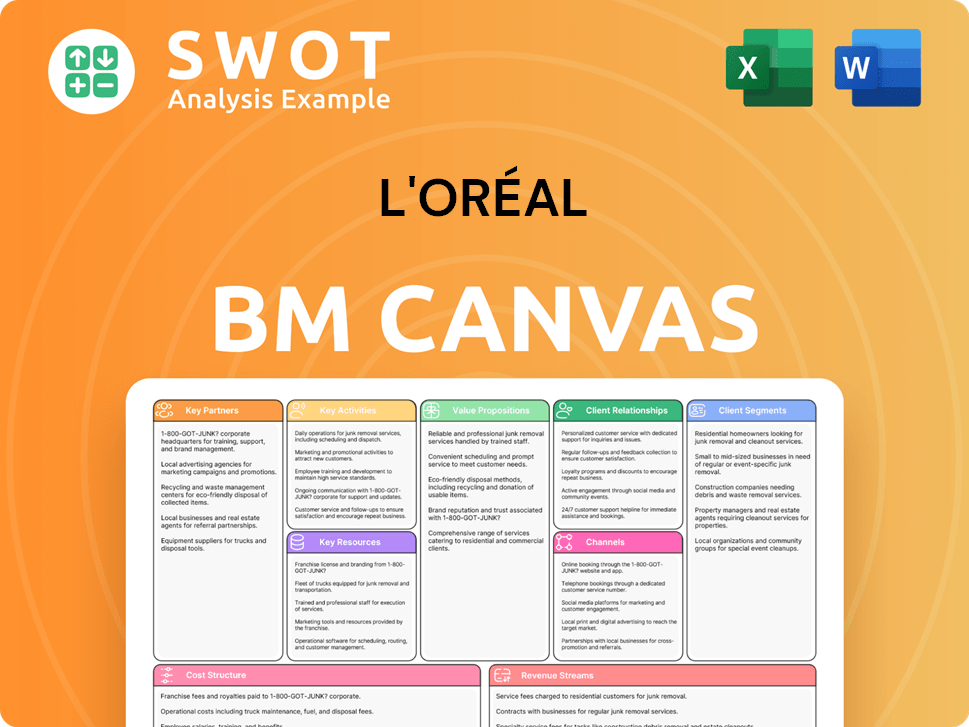
What Industry Trends Are Reshaping L'Oréal’s Competitive Landscape?
The beauty industry, a dynamic and competitive arena, sees L'Oréal navigating a landscape shaped by technological advancements, sustainability demands, and evolving consumer preferences. This L'Oréal competitive landscape is further influenced by global economic shifts and geopolitical uncertainties. The company's strategic responses to these trends and challenges will be crucial for maintaining its market position and driving future growth, as highlighted in a Brief History of L'Oréal.
L'Oréal's future hinges on its ability to adapt to these changes, leverage emerging opportunities, and maintain a strong focus on innovation and sustainability. The company's success will depend on its ability to anticipate and respond to shifts in consumer behavior, manage operational challenges, and capitalize on growth opportunities in emerging markets.
Key trends include technological advancements, such as AI-driven product development and marketing. Demand for sustainable and clean beauty products is increasing. Personalized experiences are becoming more important to consumers. These trends significantly impact the L'Oréal industry.
L'Oréal is investing heavily in Beauty Tech and AI to enhance product development, customer engagement, and operational efficiency. The company's collaboration with IBM to develop a custom generative AI formulation model, announced in January 2025, aims to accelerate innovation. AI is also used for marketing, with a rollout in the Nordics showing a 22% increase in media efficiency in 2023.
Increased competition from digital-native brands and local players requires continuous innovation. Shifting consumer preferences, like the slowdown in makeup demand in North America in Q1 2025, demand flexibility. Global economic shifts and potential tariff hikes pose challenges to profitability. The beauty industry competition is fierce.
Emerging markets, especially in SAPMENA-SSA and Latin America, offer strong growth potential. L'Oréal's 'Beauty Stimulus' Plan, launched in Q1 2025, aims to drive growth. Expansion in e-commerce, which already accounts for a significant portion of sales, is another key opportunity. Sustainability efforts, including net zero goals by 2050, align with growing consumer demand.
L'Oréal is focusing on several strategic initiatives to navigate the competitive landscape. These include investment in R&D, strategic acquisitions, and personalized beauty experiences. The company aims to achieve net zero across its entire value chain by 2050. These strategies are crucial for L'Oréal's market analysis and long-term success.
- Investment in Beauty Tech and AI.
- Expansion in emerging markets.
- Commitment to sustainability and ethical products.
- Focus on personalized beauty experiences.
L'Oréal Porter's Five Forces Analysis
- Covers All 5 Competitive Forces in Detail
- Structured for Consultants, Students, and Founders
- 100% Editable in Microsoft Word & Excel
- Instant Digital Download – Use Immediately
- Compatible with Mac & PC – Fully Unlocked
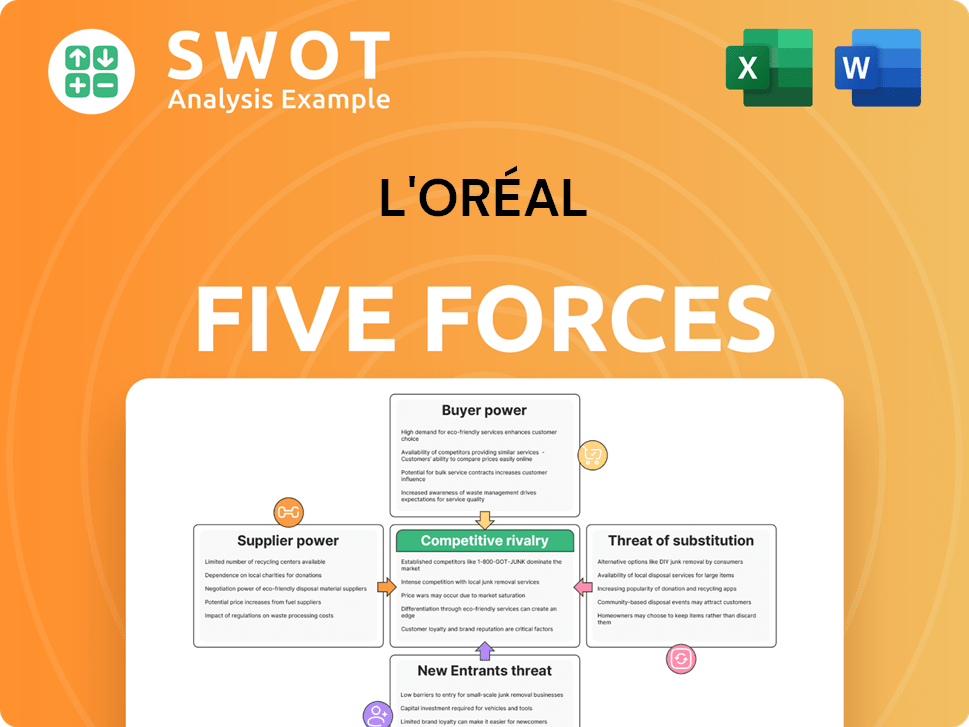
Related Blogs
- What are Mission Vision & Core Values of L'Oréal Company?
- What is Growth Strategy and Future Prospects of L'Oréal Company?
- How Does L'Oréal Company Work?
- What is Sales and Marketing Strategy of L'Oréal Company?
- What is Brief History of L'Oréal Company?
- Who Owns L'Oréal Company?
- What is Customer Demographics and Target Market of L'Oréal Company?
Disclaimer
All information, articles, and product details provided on this website are for general informational and educational purposes only. We do not claim any ownership over, nor do we intend to infringe upon, any trademarks, copyrights, logos, brand names, or other intellectual property mentioned or depicted on this site. Such intellectual property remains the property of its respective owners, and any references here are made solely for identification or informational purposes, without implying any affiliation, endorsement, or partnership.
We make no representations or warranties, express or implied, regarding the accuracy, completeness, or suitability of any content or products presented. Nothing on this website should be construed as legal, tax, investment, financial, medical, or other professional advice. In addition, no part of this site—including articles or product references—constitutes a solicitation, recommendation, endorsement, advertisement, or offer to buy or sell any securities, franchises, or other financial instruments, particularly in jurisdictions where such activity would be unlawful.
All content is of a general nature and may not address the specific circumstances of any individual or entity. It is not a substitute for professional advice or services. Any actions you take based on the information provided here are strictly at your own risk. You accept full responsibility for any decisions or outcomes arising from your use of this website and agree to release us from any liability in connection with your use of, or reliance upon, the content or products found herein.